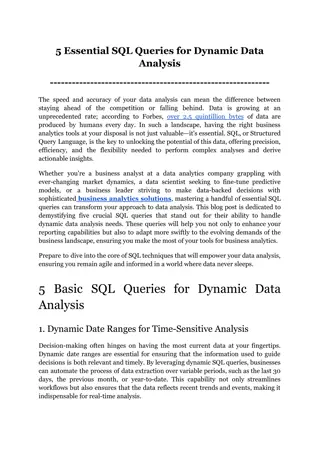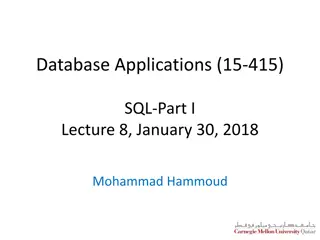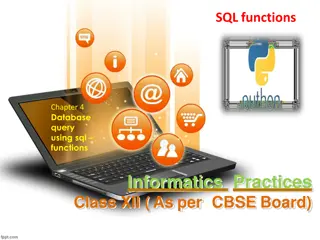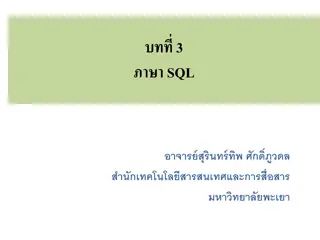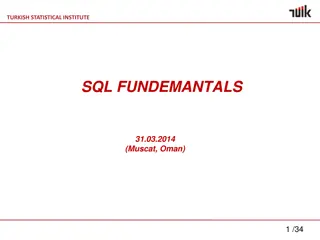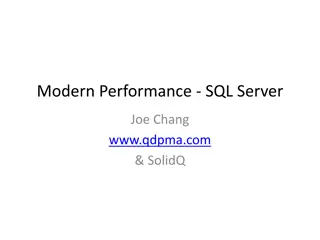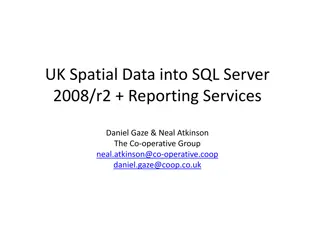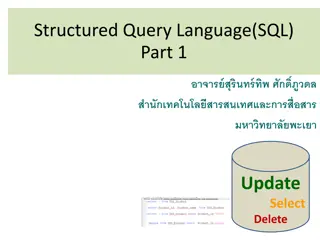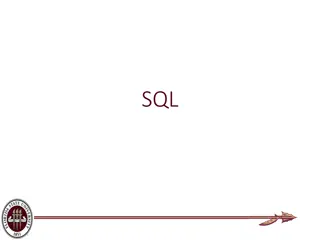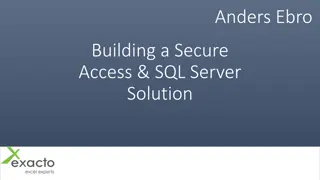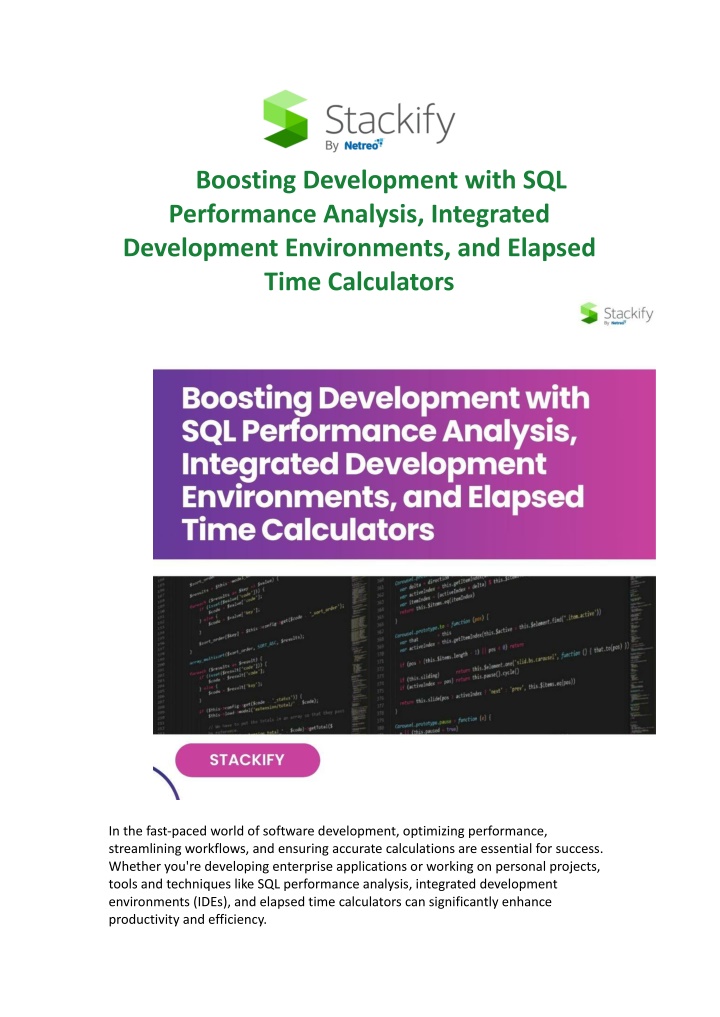
Boosting Development with SQL Performance Analysis
Boost developer productivity with insights on SQL performance analysis, integrated development environments (IDEs), and elapsed time calculators. Learn optimization techniques, best practices, and tools to streamline workflows and enhance application
Download Presentation

Please find below an Image/Link to download the presentation.
The content on the website is provided AS IS for your information and personal use only. It may not be sold, licensed, or shared on other websites without obtaining consent from the author. If you encounter any issues during the download, it is possible that the publisher has removed the file from their server.
You are allowed to download the files provided on this website for personal or commercial use, subject to the condition that they are used lawfully. All files are the property of their respective owners.
The content on the website is provided AS IS for your information and personal use only. It may not be sold, licensed, or shared on other websites without obtaining consent from the author.
E N D
Presentation Transcript
Boosting Development with SQL Performance Analysis, Integrated Development Environments, and Elapsed Time Calculators In the fast-paced world of software development, optimizing performance, streamlining workflows, and ensuring accurate calculations are essential for success. Whether you're developing enterprise applications or working on personal projects, tools and techniques like SQL performance analysis, integrated development environments (IDEs), and elapsed time calculators can significantly enhance productivity and efficiency.
This blog delves into these three areas, exploring their importance, best practices, and how developers can leverage them for better results. Understanding SQL Performance Analysis SQL (Structured Query Language) remains a cornerstone of database management, enabling developers to store, retrieve, and manipulate data efficiently. However, poorly optimized SQL queries can lead to performance bottlenecks, slowing down applications and frustrating users. This is where SQL performance analysis comes into play. Why SQL Performance Analysis Matters 1. Improved Query Efficiency: Analyzing SQL performance helps identify slow-running queries, ensuring faster data retrieval. 2. Resource Optimization: It minimizes the strain on database servers, reducing costs associated with high CPU and memory usage. 3. Enhanced User Experience: Optimized queries ensure that applications respond quickly, leading to satisfied users. 4. Scalability: Proper analysis prepares databases to handle growing data and user demands without degradation. Best Practices for SQL Performance Analysis 1. Use Indexing Strategically: Properly indexed tables can speed up search queries dramatically. Avoid over-indexing, as it can increase write operation overhead. 2. Optimize Joins and Subqueries: Ensure that joins are properly indexed and avoid excessive nesting of subqueries. 3. Monitor Execution Plans: Use tools to visualize query execution plans, identifying inefficiencies and areas for improvement. 4. Implement Query Caching: Reduce redundant database calls by caching frequently accessed data. 5. Regularly Analyze Database Metrics: Track metrics like query latency, deadlocks, and resource usage to proactively address performance issues. Tools for SQL Performance Analysis Many tools are available to assist in SQL performance optimization, including native database monitoring tools and third-party solutions. These tools can automate analysis, generate insights, and even suggest optimization techniques, saving time and effort for developers. The Role of Integrated Development Environments (IDEs)
An Integrated Development Environment (IDE) is a developers virtual workbench, combining essential tools like code editors, debuggers, and build automation into a single interface. Modern IDEs go beyond basic functionality, offering features that boost productivity and streamline workflows. Key Features of IDEs 1. Code Editing: Syntax highlighting, auto-completion, and code suggestions help developers write clean, error-free code. 2. Debugging: Built-in debuggers allow developers to step through code, identify bugs, and resolve them efficiently. 3. Version Control Integration: Seamless integration with Git and other version control systems simplifies collaboration and code management. 4. Testing Support: Many IDEs include tools for unit testing, ensuring that code works as expected before deployment. 5. Customizability: Developers can tailor IDEs with plugins and extensions to meet specific project requirements. Popular IDEs in the Developer Community Visual Studio Code: A lightweight yet powerful editor, known for its vast extension ecosystem. IntelliJ IDEA: A Java-centric IDE favored for its intelligent code assistance and robust features. Eclipse: A versatile IDE widely used for Java and other programming languages. PyCharm: Tailored for Python development, offering advanced debugging and testing capabilities. Choosing the Right IDE When selecting an IDE, consider factors like the programming language, project complexity, and team collaboration requirements. A well-suited IDE can dramatically improve efficiency and reduce development time. Streamlining Workflows with Elapsed Time Calculators Time is a critical factor in software development. Developers often need to measure the time taken for processes like database queries, code execution, or deployment pipelines. Elapsed time calculators are invaluable tools for this purpose, ensuring accuracy and aiding in optimization. What Are Elapsed Time Calculators? An elapsed time calculator measures the duration between two events. These tools can be as simple as a stopwatch or as complex as software solutions integrated into development environments.
Applications of Elapsed Time Calculators 1. Performance Testing: Measure how long specific code segments or queries take to execute. 2. Workflow Optimization: Analyze time-consuming tasks in development pipelines to identify bottlenecks. 3. Monitoring System Performance: Track response times for APIs, servers, and applications. 4. Project Management: Calculate the time spent on various tasks to improve time estimates for future projects. How to Use Elapsed Time Calculators Effectively 1. Integrate with IDEs: Many IDEs include built-in tools or plugins for measuring elapsed time during code execution. 2. Automate Timing in Scripts: Use programming languages like Python or JavaScript to log start and end times of processes. 3. Visualize Data: Tools that present elapsed time metrics in charts or graphs make it easier to interpret and act on the data. 4. Compare Benchmarks: Regularly compare elapsed times across different code versions or configurations to ensure consistent performance improvements. Examples of Elapsed Time Calculators Command Line Utilities: Tools like Unix s time command help measure script execution times. Online Calculators: Web-based tools offer quick calculations for simple tasks. Integrated Tools: Many APM (Application Performance Management) platforms include elapsed time tracking as part of their feature set. Bringing It All Together Combining SQL performance analysis, IDEs, and elapsed time calculators creates a powerful toolkit for developers. Here's how you can integrate these tools into your workflow: 1. Start with Performance Analysis: Use SQL performance analysis techniques and tools to optimize database queries and improve application speed. 2. Leverage IDEs for Efficiency: Choose an IDE that aligns with your project needs and customize it with extensions to boost productivity. 3. Measure and Optimize Time: Utilize elapsed time calculators to track and refine processes, ensuring every second counts. Conclusion
The journey to becoming a more efficient and effective developer involves mastering the tools and techniques that address critical areas of performance and productivity. SQL performance analysis ensures robust and responsive database operations. Integrated development environments streamline the coding process, while elapsed time calculators provide the insights needed to optimize workflows. By adopting these practices and leveraging the right tools, developers can not only meet but exceed their project goals, delivering high-quality software that performs seamlessly. Start integrating these strategies into your workflow today and experience the transformation in your development process. Start your free trial today:- https://stackify.com/free-trial/

